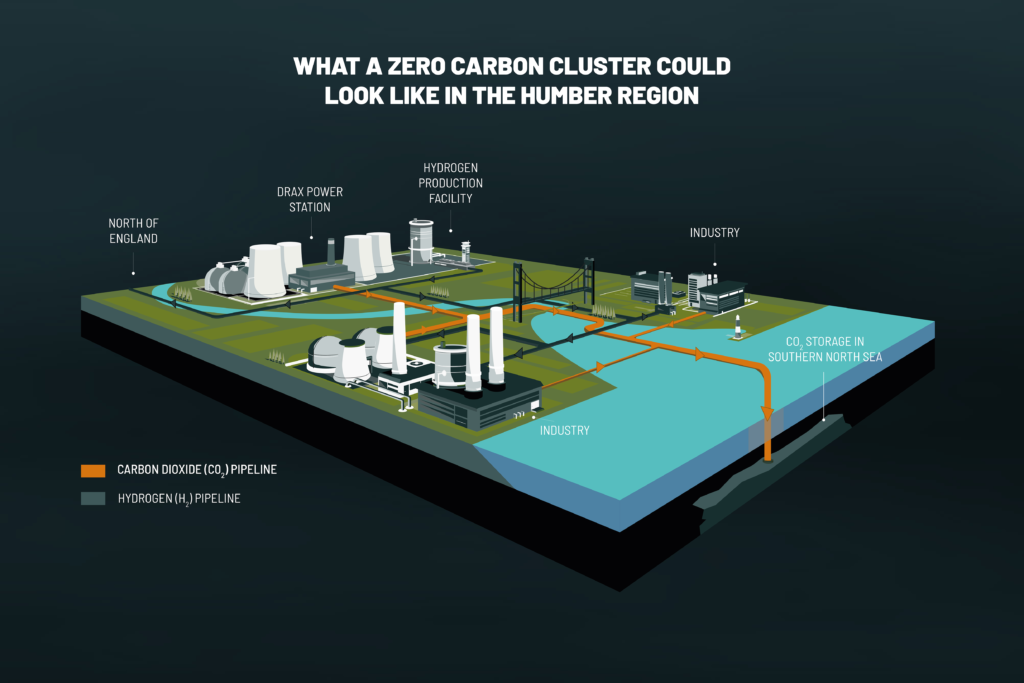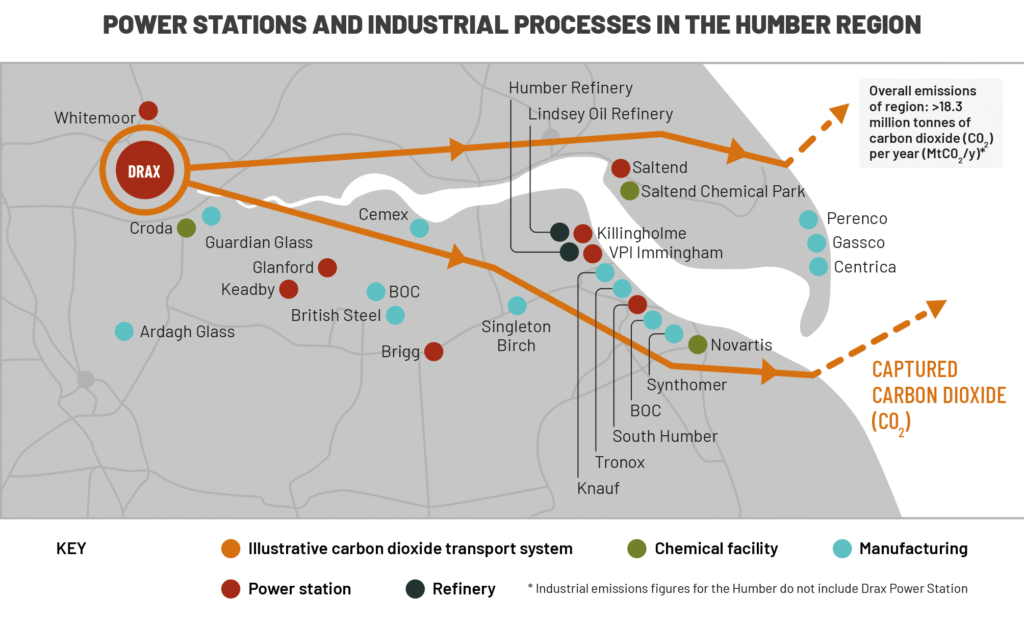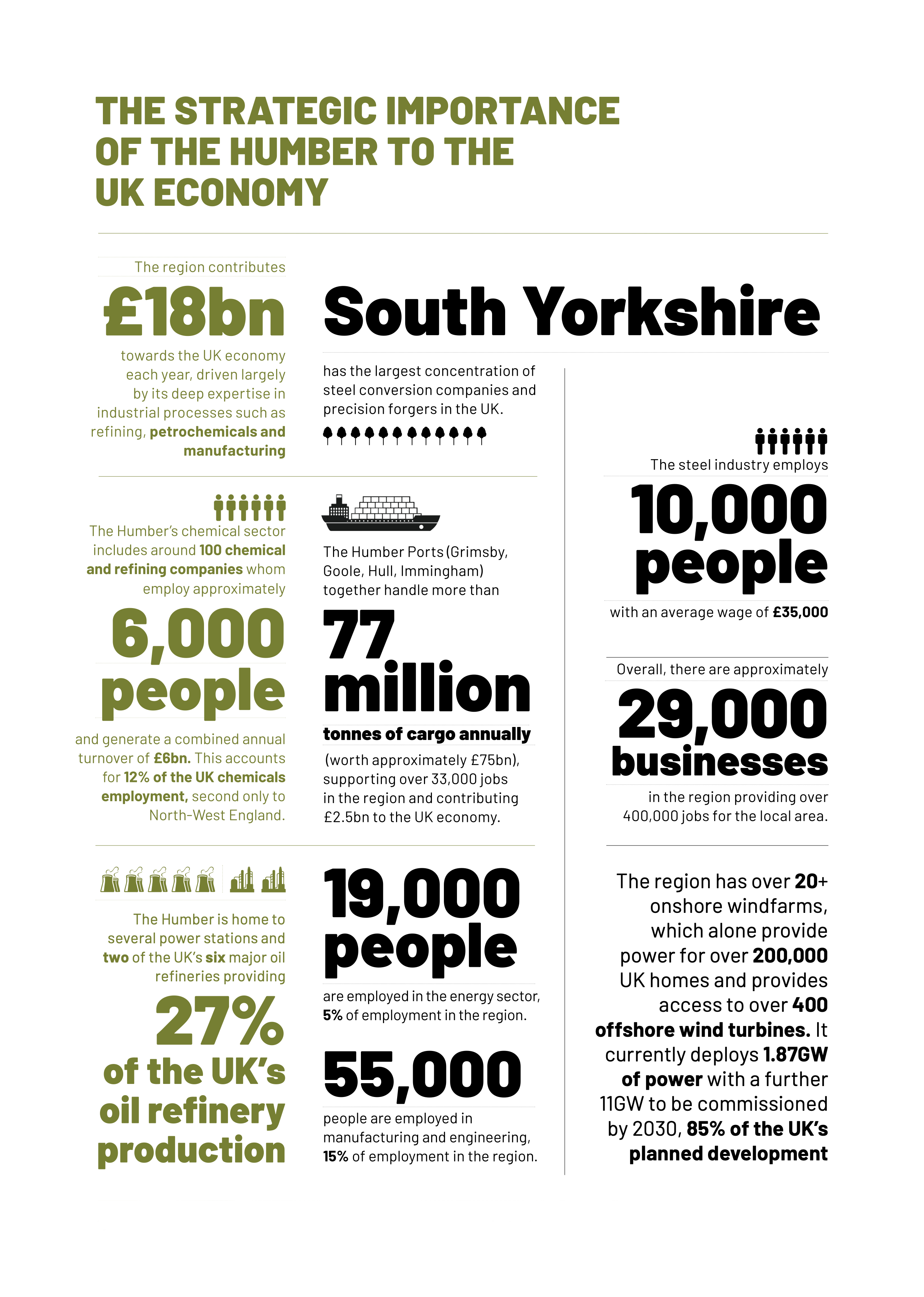-
New ambitious proposals published to create world’s first net-zero carbon industrial cluster by 2040 in the Humber region
-
The roadmap would help protect 55,000 industrial jobs by helping firms decarbonise, saving £27.5bn in carbon taxes by 2040
-
The region could make a bigger contribution to UK’s climate goals than any other industrial cluster – capturing 15% of the UK’s current annual CO2 emissions
-
All parties urged to adopt roadmap in manifestos for government
A new report providing the most detailed assessment yet of how the UK can develop the world’s first zero carbon industrial cluster has been published.
The proposals published by the Zero Carbon Humber campaign, led by multinational energy firms Drax Group, Equinor and National Grid Ventures, could help protect 55,000 jobs and deliver the biggest contribution to the UK’s climate goals of any industrial region.
Capture For Growth: A roadmap for the world’s first zero carbon industrial cluster sets out how the region could deliver the government’s world-leading ambition to establish the first ‘net zero’ carbon industrial cluster in the UK by 2040, helping the Humber to compete on the world stage by attracting new investment, industries and employment.
The proposals are supported by new analysis by Element Energy which finds that if the world’s first net zero carbon industrial cluster is developed in the Humber region, 53 million tonnes of CO2 a year could be captured – that’s around 15% of the UK’s current annual CO2 emissions. They would also help save industrial businesses in the region carbon taxes of up to £27.5bn by 2040 helping to protect jobs and competitiveness.
Lord Haskins, Chair of the Humber Local Enterprise Partnership, which is supporting the Zero Carbon Humber campaign, said:
“I welcome these proposals which set out a clear route to protect jobs, tackle climate change and help the Humber compete globally. Today, the UK is in the lead, but other countries are closing the gap by helping their industries achieve their net zero carbon goals.
“The Humber is uniquely well placed to deliver clean growth, and I hope the next Government will get behind the exciting proposals coming forward from the region.”
Will Gardiner, CEO of Drax Group commented:
[caption id="attachment_670" align="aligncenter" width="1024"]“The race to cut carbon emissions is one we can win. This plan sets out a clear blueprint of how to get the Humber to net zero – the impact of decarbonising the most carbon intensive region in the country will make a major contribution to the UK reaching its world-leading climate goals. We need to seize this opportunity. Zero starts here.”
 Click to view/download infographic.[/caption]
Click to view/download infographic.[/caption]
Irene Rummelhoff, Executive Vice President, Marketing, Midstream & Processing at Equinor added:
“This report sets out how a hydrogen economy can be kick-started from the Humber region and grow across the North of England. Hydrogen has a key role to play in the UK reaching net zero by cleaning up industry, heating, transport and power, as well as delivering improved air quality.”
Jon Butterworth, COO, Global Transmission at National Grid Ventures said:
“The government has set out ambitious plans to develop the world’s first zero carbon industry cluster by 2040. We believe this is a challenge that can and should be met. By working together across industry sectors, we can protect UK jobs, drive further economic growth and help the country achieve critically important climate goals that will significantly benefit current and future generations.”
The UK is among the top five nations in the race to decarbonise industry by using carbon capture and storage (CCS), but risks falling behind as other countries move to deploy CCS at scale.
[caption id="attachment_666" align="aligncenter" width="1024"] Click to view/download infographic.[/caption]
Click to view/download infographic.[/caption]
The report shows that the Humber is ideally positioned to become the world’s first net zero industrial cluster:
- The region is home to the UK’s biggest industrial economy, employing 55,000 people and contributing £18bn to UK GDP each year.
- It has a rich industrial heritage and hosts around 100 chemical and refining companies alone, which together account for around 12% of total employment in the UK chemicals sector.
- The Humber is also the UK’s largest emitter of CO2. Industries could face carbon taxes of up to £27.5bn by 2040 which would harm competitiveness.
- A world leading trial of bioenergy carbon capture and storage (BECCS) technology is underway at Drax’s power plant in North Yorkshire, which could create the world’s first negative emissions power station.
- This power station could then be used as the economic anchor to make a carbon capture pipeline across the Humber viable - enabling industrial businesses in the region to capture the carbon they emit
- A new hydrogen production facility could kick start a hydrogen economy in the region covering industry, heating for homes and businesses, power generation and transport. Cleaner transport alone could remove 4.2 million tonnes of CO2 from the region, improve air quality and save the NHS millions of pounds.
- The Committee on Climate Change (CCC) said earlier this year that deploying carbon capture and hydrogen technologies at scale is essential if the UK is to meet its legally binding target of net zero carbon emissions by 2050.
- The Humber is also close to potential major geological storage sites for CO2 emissions deep beneath the Southern North Sea.
The publication of Capture For Growth: A roadmap for the world’s first zero carbon industrial cluster follows the recent launch of a government consultation into its £315m Industrial Energy Transition Fund which is intended to help industry reduce carbon emissions.
[caption id="attachment_667" align="aligncenter" width="2550"] Click to view/download infographic.[/caption]
Click to view/download infographic.[/caption]
ENDS
Media contacts:
Ali Lewis
Drax Group Head of Media & PR
E: [email protected]
T: 07712670888
Eskil Eriksen
Equinor Media Relations Manager
E: [email protected]
Simmie Korotane
National Grid Media Relations Officer
E: [email protected]
T: 07971343383
Notes to editors:
- In May Drax Group, National Grid Ventures and Equinor announced they had signed a Memorandum of Understanding committing them to work together to explore how a large-scale carbon capture usage and storage (CCUS) network and a hydrogen production facility could be constructed in the Humber in the mid-2020s.
- The Zero Carbon Humber vision includes:
- Developing a hydrogen demonstrator and test facility in the Humber.
- Installing carbon capture technology at Drax Power Station to create the world’s first carbon negative power station.
- Building a carbon dioxide (CO2) transport and storage system across the region that industry can connect to;
- Safely storing carbon deep under the seabed in the Southern North Sea.
- Unlocking a cutting-edge hydrogen economy – providing a low carbon fuel to decarbonise industry, power, heat, transport and maritime across the North of England.
- Creating the conditions for new industries which use the CCUS pipeline or low carbon hydrogen to develop in the region – creating new jobs and opportunities locally and across the country.
- The Committee on Climate Change’s ‘Net Zero’ report states that BECCS could generate up to 173 TWh of electricity by 2050, capturing up to 51 million tonnes of CO2 – around half of the remaining carbon in the economy that the UK will need to capture to become ‘net zero’.
- The CCC’s Net Zero report also identified that at least one of the UK’s CCUS regional clusters should involve substantial production of low-carbon hydrogen by 2030 to stay ‘on track’ for net zero. It also recommends that infrastructure development for CCUS should start as early as possible, in all regional clusters with large industrial emissions.
- The recently published H21 North of England study has also shown that up to 3.7 million homes as well as other industrial processes could be converted from natural gas to hydrogen to meet the UK’s climate change targets.
- The estimate for carbon taxation receipts facing Humber industrials in 2040 is based on the ‘low’ and ‘high’ scenarios for carbon pricing forecast in the HM Treasury Green Book 2018
- The UK’s Committee on Climate Change (CCC) estimates the price of decarbonisation will cost as little as 1% of forecasted GDP per annum in 2050.
- However, the Business, Energy and Industrial Strategy (BEIS) Select Committee inquiry found that failure to deploy CCUS and BECCS technology could double the cost to 2%.
About Zero Carbon Humber
- The founding partners of the Zero Carbon Humber campaign include:
- The Humber Local Enterprise Partnership: The Humber LEP is a partnership of businesses, educational institutions and the four Humber local authorities working together to promote and develop the area surrounding the Humber Estuary and provide strategic economic leadership to create jobs and deliver growth.
- CATCH: CATCH is an industry led partnership supporting the process, energy, engineering and renewable industries in the Humber region.
- Drax Group: Drax owns and operates a portfolio of flexible, low carbon and renewable electricity generation assets across Britain. The assets include the UK’s largest power station, based at Selby, North Yorkshire, which supplies six percent of the country’s electricity needs.
- Equinor: Equinor is a global energy company committed to long-term value creation in a low carbon world. It is the largest provider of oil and natural gas to the UK. Its three UK offshore wind farms include Hywind Scotland, the world’s first floating wind farm, and it is a partner in the world’s largest wind farm at Dogger Bank. It has been a world leader in carbon capture and storage for over 20 years.
- National Grid Ventures: National Grid Ventures (NGV) is part of National Grid plc, one of the world’s largest investor-owned energy companies. Separate from National Grid’s core regulated businesses, NGV develops, operates and invests in energy projects, technologies and partnerships to accelerate the development of a clean energy future for consumers.
More information about the Zero Carbon Humber campaign is available on the website.